*The painter ChatGPT “A dramatic poker game scene in a dimly lit casino with a player confidently going all-in in Texas Hold’em.”
Bet Amounts in Pre-flop
In my previous post, I wrote that at tables with a lot of beginners, tight aggressive players seem weaker than I expected, and I think I’ve figured out why, so the purpose of this article is to briefly explain it. Pre-flop betting strategies are explained in all poker books, and since there aren’t that many possible hand combinations, it’s probably best to just play according to the standard rules. I think even beginners will be able to easily imitate and put into practice after reading one book.
In games where players have around 100bb chips, pre-flop bet amounts generally fall into the following categories:
- Call Range (1-4bb)
- 3-bet range (7-12bb)
- 4-bet range (20~30bb)
- 5-bet range (40~All-in).
Depending on the hand, the probability of choosing each option, such as folding, calling (raising) in the call range, or calling (raising) in the 3-bet range, is determined based on the Nash equilibrium strategy. Bets of four or more are probably often the result of multiple players raising their bets in an attempt to become the aggressor when they have strong hands. In Texas Hold’em, the opening raise is chosen to be between 2 and 4 times the bet. If you suddenly raise to the 3-bet range, you will be revealing the strength of your hand, and if all other players fold, you will gain very few chips even if you win.
This is just a guess, but I would imagine that when experienced players play together, the bet amount chosen for most games would be within the 3 bet range. This is the bet amount where one player raises in the first half and another player re-raises in the second half. The bet amount is too high to enter with a mediocre hand, so it is equivalent to a bet that would fold with about 90% of the cards. However, in most games between beginners, there is no player or only one who raises, and the preflop ends with a bet amount within the call range. Occasionally, players will raise into the 3-bet range, but most of the time they have very strong hands. Additionally, I think many beginner players tend to fold when faced with a player who raises up to the 3-bet range. This means that there is no need to go out of your way to fight an opponent with a strong hand. As a result, it is common for strong hands to only get a few chips. In games with a lot of beginners, there doesn’t seem to be much benefit to raising to the 3-bet range.
Another reason may be that the game I play does not involve money, but there are quite a few players who wait until they have enough chips in the pot before going all-in (apparently it’s called steal.). Since I wasn’t planning on betting all my chips, I often found myself having to fold even when I had a strong hand. Therefore, raising the bet pre-flop seems to involve a fair amount of risk. This may be why so many players try to limp in and get through preflop.
As a result, even when there are six beginners playing together, in many games there are four to six players left until the flop. Normally, only two or three players would remain on the flop, and from this round onwards, there would be a lot of psychological warfare and negotiating involved, but with six players left, it may no longer be a situation where psychological warfare or negotiating is an option. In addition, while calculating the probabilities, I noticed that the value of the hand changes slightly depending on the number of players remaining at the end of the preflop, and I believe this is the reason why tight aggressive players appear weaker. The winning probability for specific hands is as follows.
Probability of Winning per Remaining Players
Usually, the number of participants is narrowed down to just two or three at the preflop stage, so you might think that the value of the two hole cards dealt preflop doesn’t change much depending on the situation. Also, the players will likely be coming in with stronger hands than usual. For example, it is unlikely that any player will come into the flop with a hand like 27o or 63o.
However, when playing against other beginners, the entry cost of moving from preflop to the flop is low, so many players come through to the flop with a fairly wide range of hands. The value of your hand often changes significantly during the transition from pre-flop to the flop, so hands that are considered premium hands on the flop (such as AA, KK, AKs) can become almost worthless, and hands like 27o or 63o can become some of the strongest hands depending on the cards revealed. Therefore, even if we calculate the probability of winning while ignoring the effect of elimination due to pre-flop betting, we can still recognize a certain degree of validity in assessing the value of our hand. This probability of winning can be calculated using Monte Carlo simulation. As an evaluation criterion, if the number of participants is \(\small n\), and the probability of winning \(\small p\) satisfies
\[ \small p > \frac{1}{n},\]
then the hand would be one that justifies entering the flop. The results of calculating this for each number of players \(\small n\) are as follows. As in most poker books, the top right corner of the table is Suited (“s”) and the bottom left is Off-suited (“o”).
\(\small [n=2] \)
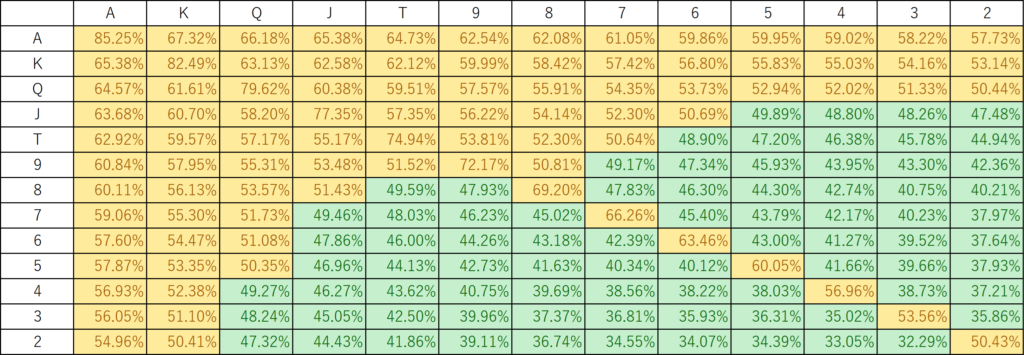
\(\small [n=3] \)
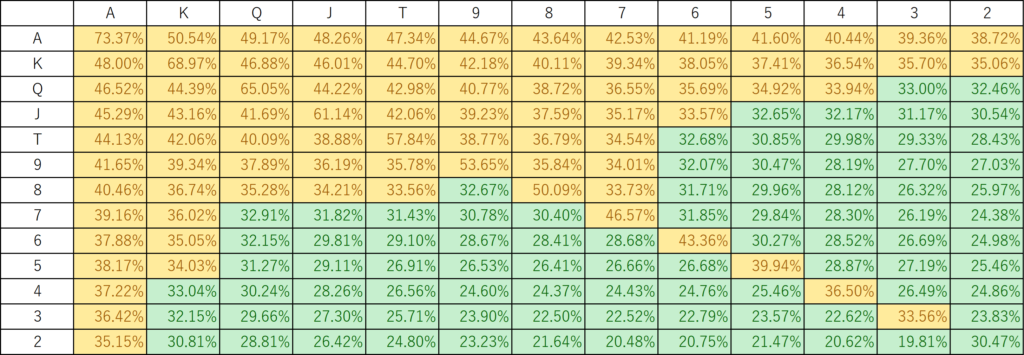
\(\small [n=4] \)
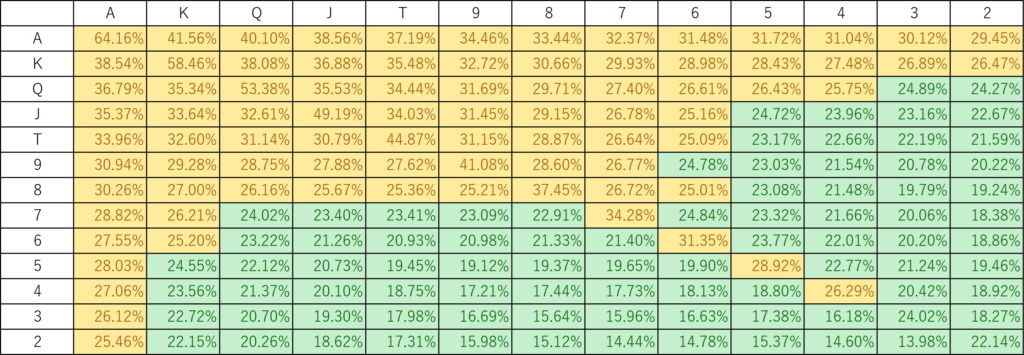
\(\small [n=5] \)
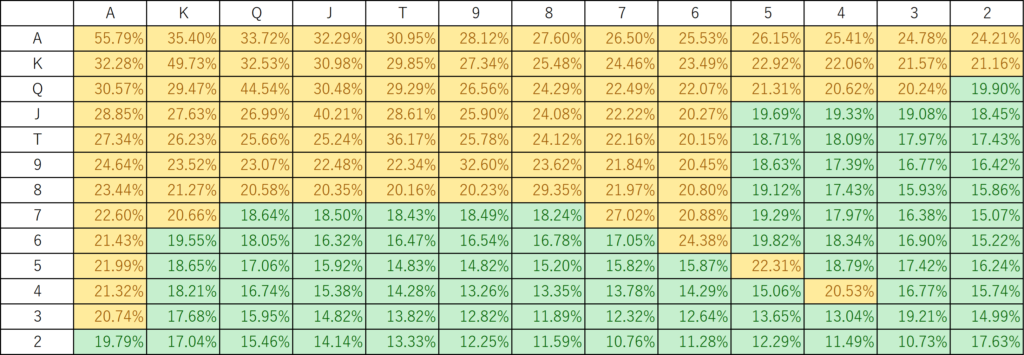
\(\small [n=6] \)
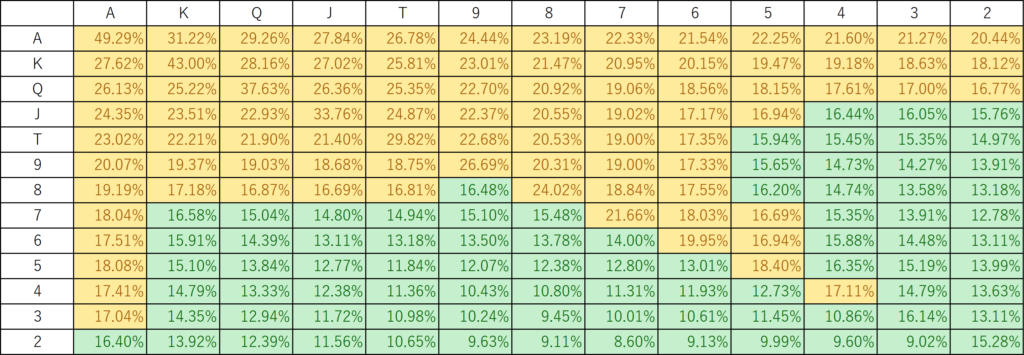
Why Tight-aggressive Seems Weak in Games with a lot of Beginners
If you look closely at the calculations in the table, you will notice the following trends:
- As the number of participants increases, the winning rate of hands that complete a hand with a ranked pair (Off-suited, Pocket Pair) decreases relatively.
- The more participants there are, the higher the chance of winning with a suited hand that is easier to complete a flush.
This may seem trivial at first glance, but I suspect this is why tight-aggressive players are weak in a game with a lot of beginners. The basic format for a tight aggressive player is to make a pair of high-ranking cards (one pair or two pair) and then aggressively raise their bets to eliminate other players and win. In other words, this style is more effective when one pair and two pairs are more valuable than other hands. The fewer the number of participants, the more likely it is that such a situation can be created, so this playing style is suitable when raising the bet pre-flop to limit the number of participants.
On the other hand, in games with a lot of beginners, there tends to be a large number of participants at the time of the flop, so the value of one pair and two pair is relatively lower, and conversely, hands that can aim for a flush or straight are more valuable. As a result, a strategy of raising the bet by making a high-ranking one pair or two pair is likely to be jeopardized by players who make a flush or straight. If the number of players is limited by the time of the flop, players with hands that could make a flush or straight are likely to be left out, but if there are a lot of participants at the time of the flop, there is a high chance that players aiming for a flush or straight will remain.
If there are six players remaining at the flop stage, even if you flop a pair of Aces (one of which is the player’s hand), your chances of winning are significantly lower than when playing with experienced players, so aggressively raising your bet in this situation is not necessarily a rational choice. My hypothesis is that this is the reason why tight aggressive players appear weak in a game with a lot of beginners.
Preflop Entering Hand Range
I suppose you should just follow the instructions in the poker book, but since I’ve included it in the title, I’ll write it down anyway. Depending on how small the table is at the end of the preflop, you can’t go too far wrong by entering with a hand that gives you a higher probability of winning than a certain threshold. For example, if you think that most players will be tight-aggressive and that the table will usually be narrowed down to two players, then you can base your range on the probability of winning when there are two players.
Generally, in Texas Hold’em, the earlier you are in the decision-making position, the more disadvantaged you are, so it is a good idea to set your winning probability threshold for entry higher. When playing with six people, decisions are made in the following order: UTG, MP, CO, BN, SB, BB (I think you could also use 1, 2, 3, 4, 5, 6 instead of symbols), and the threshold could be set to, for example,
- UTG: 60%
- MP: 58%
- CO: 56%
- BN: 54%
- SB: 52% × (bet – 0.5bb) / (bet)
- BB: 50% × (bet – 1bb) / (bet).
Note that SB and BB have already posted their blinds, so they need to discount the threshold by that amount. If the bet remains at 1bb and reaches the BB, you will definitely have to check or raise. When players other than the SB enter, they are required to start with a raise, which seems to be intended to prevent the SB and BB from entering with an unclear hand. The specific entry range in this case is as follows. SB and BB are calculated when the bet is 9bb.
1. UTG(Under the Gun)
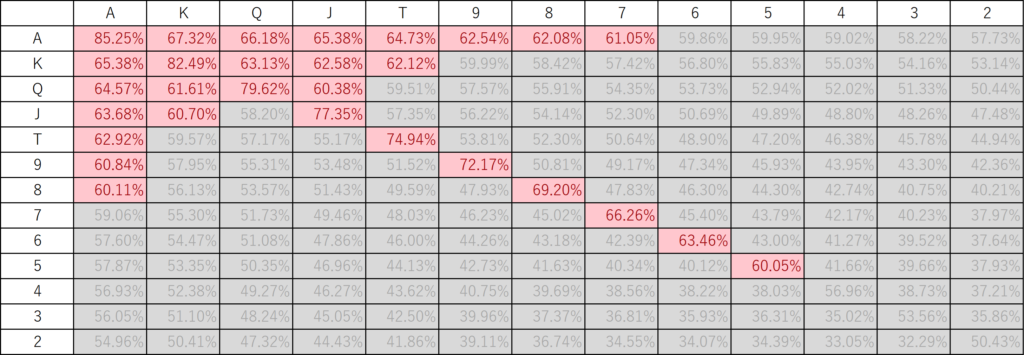
2. MP(Middle Position)
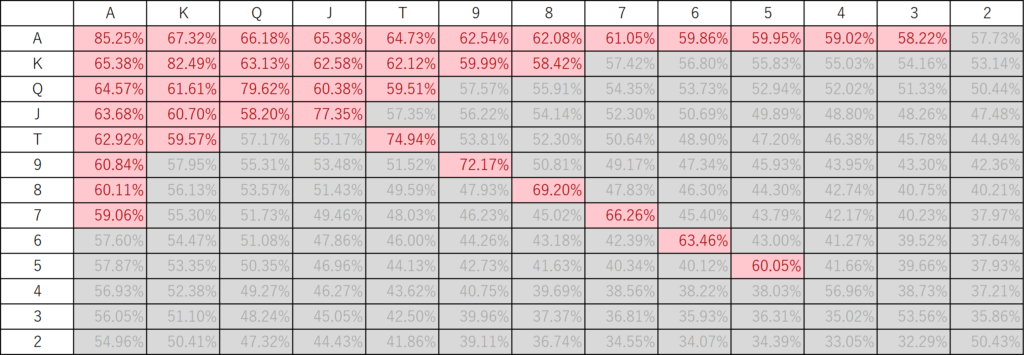
3. CO (Cut Off)
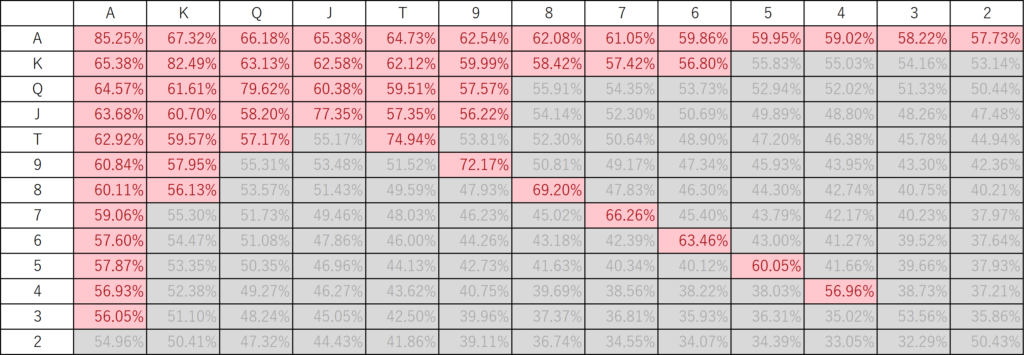
4. BN (Dealer Button)
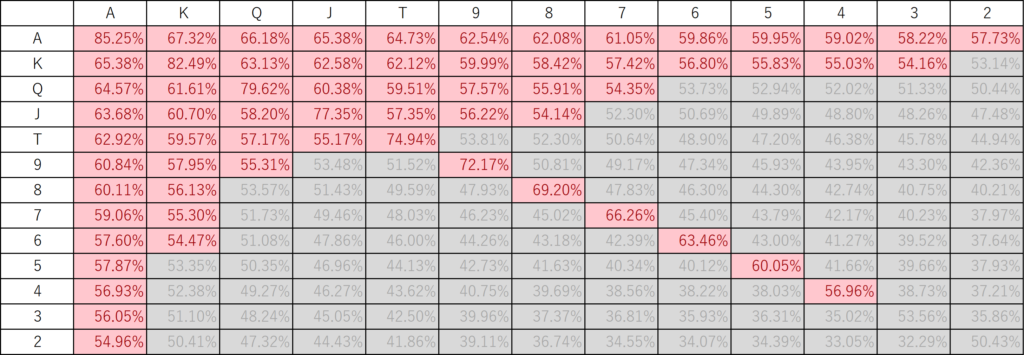
5. SB
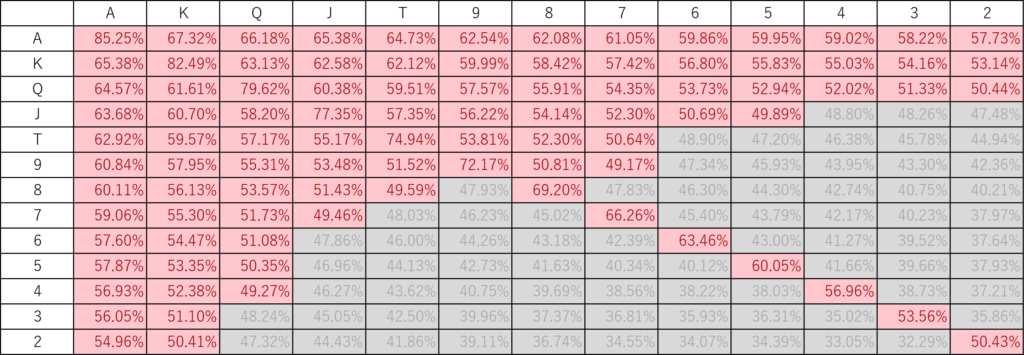
6.BB
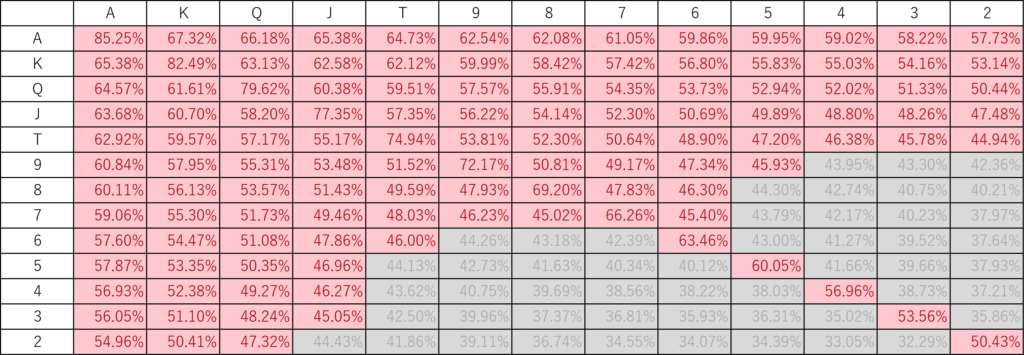
If the hand is in the 3-bet range (UTG or MP, this is from the second round onwards), you should set this threshold higher to narrow down your hand. It might be better to use the range in the UTG table or a narrower range (win rate of 62-64% or higher). Unless the SB or BB have a 3-bet range on the first round, they will most likely end up with a calling range, so they can enter with a wide hand. Occasionally, someone will limp in on the first round and then reraise your open-raise, which can be annoying (if someone is in a bad mood, you’ll get into a raising battle and end up all-in preflop), but this isn’t something that happens very often.
If there are many beginners and most games end with a calling range preflop, you can lower the entry threshold and use a value of around 5 people for the win probability table. For example, in a table of the probability of winning for five people, the threshold is set as:
- UTG: 24.0%
- MP: 23.2%
- CO: 22.4%
- BN: 21.6%
- SB: 20.8% × (bet – 0.5bb) / (bet)
- BB: 20.0% × (bet – 1bb) / (bet).
The specific entry range in this case is as follows. SB and BB are calculated when the bet is 3bb.
1. UTG
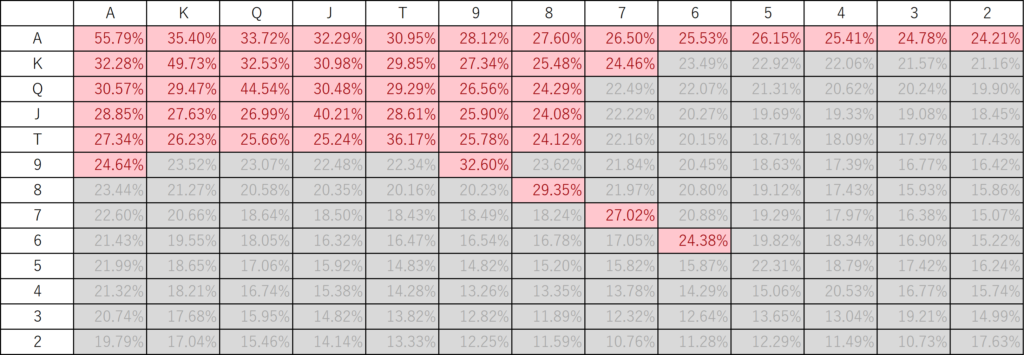
2. MP
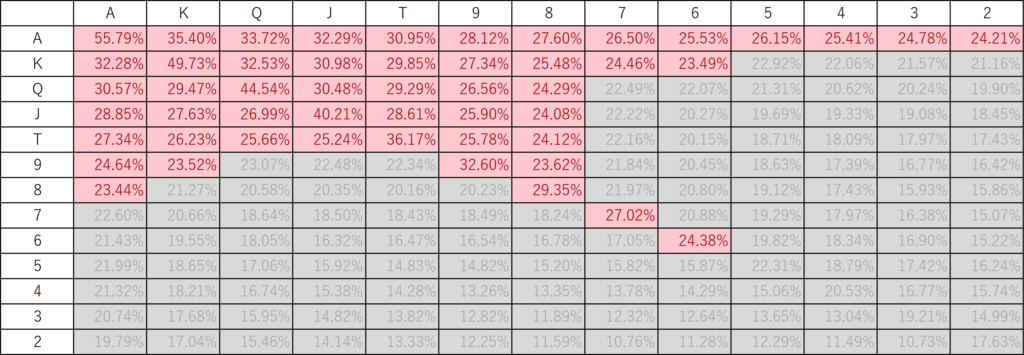
3. CO
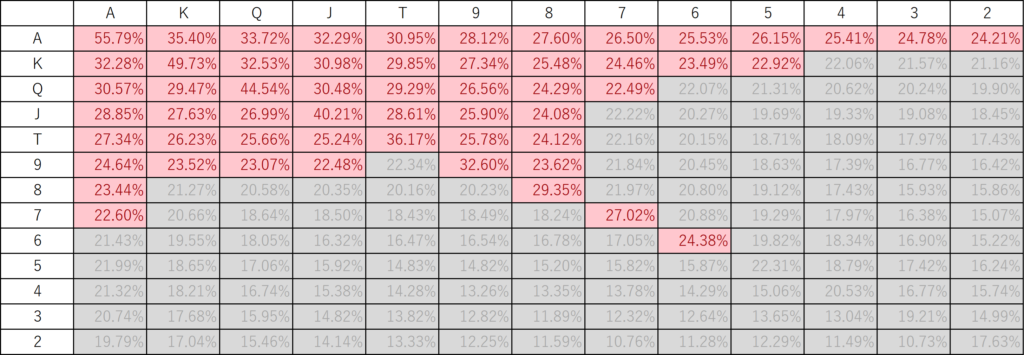
4. BN
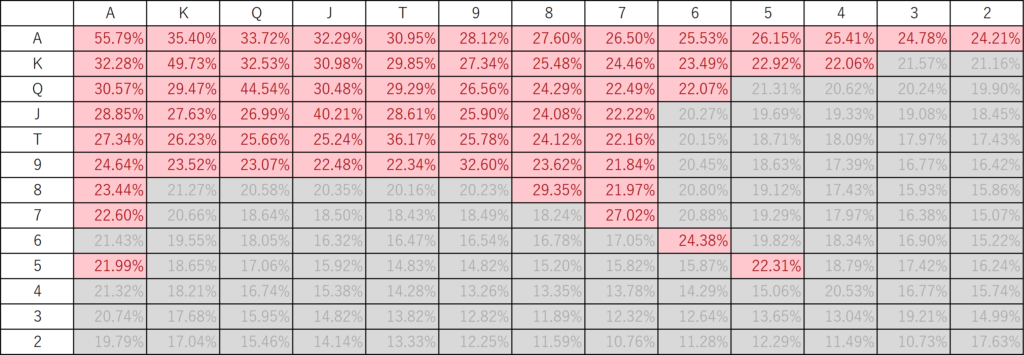
5. SB
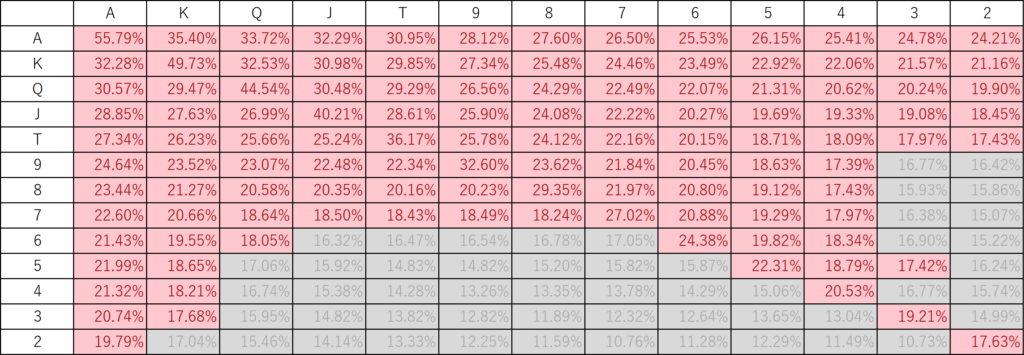
6. BB
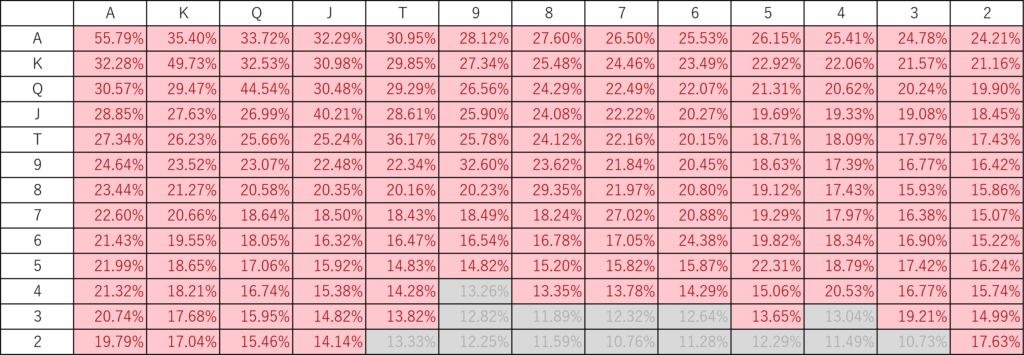
These are just examples and they can be set tighter or looser. From my experience playing, I didn’t feel that tight was strong or loose was weak (although I don’t know about the situation when strong players are playing against each other). In games with a large beginner base, it seems impossible to use a textbook strategy in the first place (3-bet ranges are almost non-existent), so it’s a good idea to decide on a strategy that suits your style and the characteristics of your opponent. Of course, you need to decide on a higher entry rate and bet amount for hands with a higher winning rate.



Comments